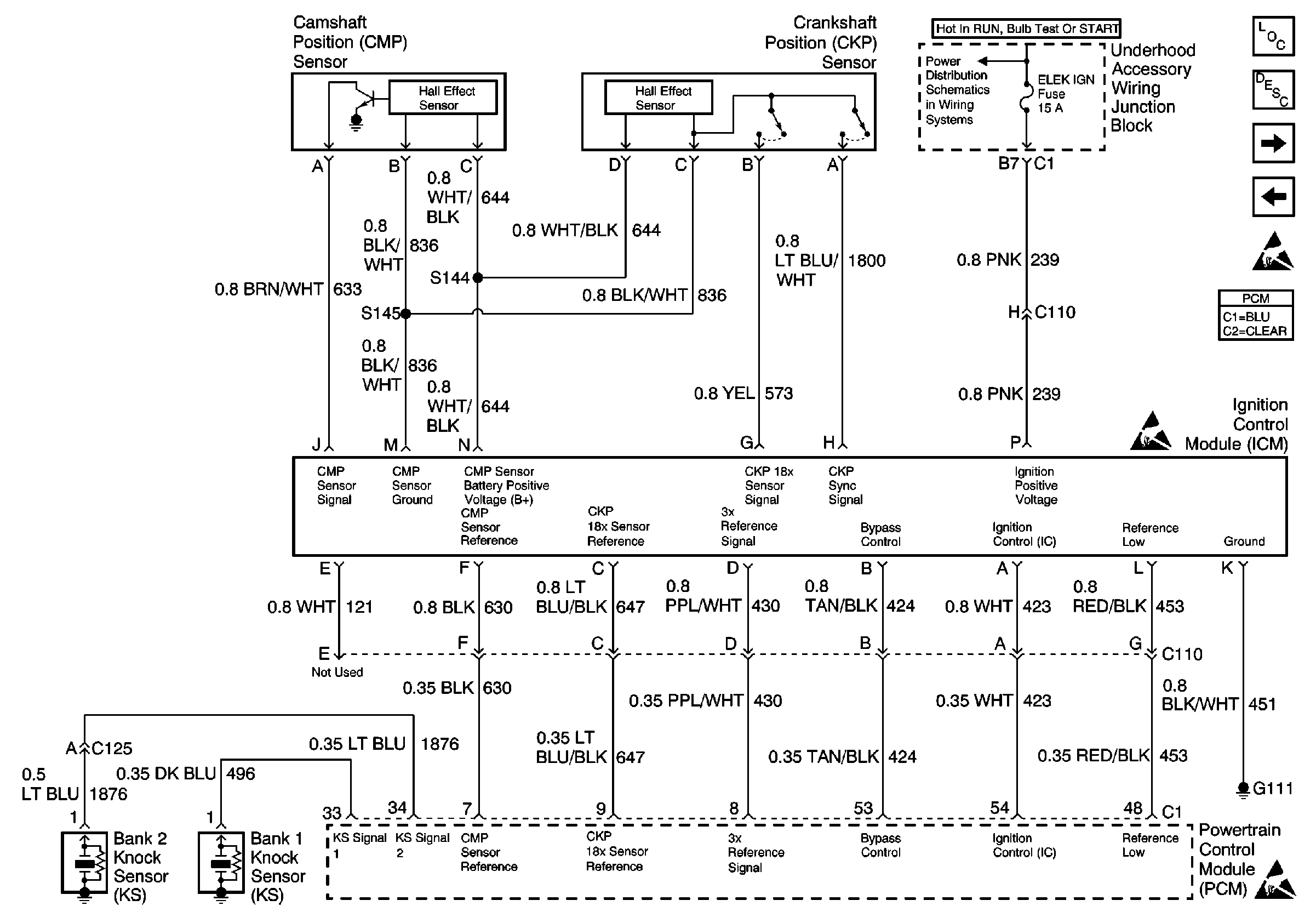Refer to Engine Controls Schematic
Crankshaft and Camshaft Position Sensors

.
Circuit Description
The 3X reference signal is produced by the ignition control module (ICM). The ICM calculates the 3X reference signal by dividing the crankshaft position (CKP) sensor 18X pulses by 3 when the engine is running and CKP sync pulses are also being received. The powertrain control module (PCM) uses the 3X reference signal to calculate engine RPM and crankshaft position at engine speeds above 1200 RPM. The PCM also uses the pulses on this circuit to initiate injector pulses. The PCM constantly monitors the number of pulses on the 3X Reference circuit and compares the number of 3X reference pulses to the number of 18X reference pulses and CAM signal pulses being received. If the PCM receives an incorrect number of pulses on the 3X Reference circuit, the PCM will use the 18X Reference signal circuit for fuel and ignition control. The engine will continue to start and run using the 18X reference and camshaft position PCM input signals only. DTC P1374 will set.
Conditions for Running the DTC
The engine has been running for longer than 3 seconds.
Conditions for Setting the DTC
| • | The ratio of 18X reference pulses to CAM signal pulses received by the PCM equals 36:1. |
| • | The ratio of 18X reference pulses to 3X reference pulses received by the PCM does not equal 6:1. |
| • | The conditions are present for more than 10 seconds. |
Action Taken When the DTC Sets
| • | The PCM will illuminate the malfunction indicator lamp (MIL) during the second consecutive trip in which the diagnostic test has been run and failed. |
| • | The PCM will store conditions which were present when the DTC set as Freeze Frame/Failure Records data. |
Conditions for Clearing the MIL/DTC
| • | The PCM will turn OFF the malfunction indicator lamp (MIL) during the third consecutive trip in which the diagnostic has run and passed. |
| • | The history DTC will clear after 40 consecutive warm-up cycles have occurred without a malfunction. |
| • | The DTC can be cleared by using a scan tool. |
Diagnostic Aids
Test for the following conditions:
| • | Malfunctioning ignition coil -- Remove the ignition coils and inspect the ignition control module and coils for cracks, carbon tracking, or other signs that indicate that the coil secondary circuit is arcing to the ICM or ICM wiring harness. Refer to Ignition Coil Replacement . |
| • | Secondary ignition wires arcing to wiring harness -- Inspect secondary ignition wires for carbon tracking or other signs of damage. |
Many situations may lead to an intermittent condition. Perform each inspection or test as directed.
Important: : Remove any debris from the connector surfaces before servicing a component. Inspect the connector gaskets when diagnosing or replacing a component. Ensure that the gaskets are installed correctly. The gaskets prevent contaminate intrusion.
| • | Loose terminal connection |
| - | Use a corresponding mating terminal to test for proper tension. Refer to Testing for Intermittent Conditions and Poor Connections , and to Connector Repairs in Wiring Systems for diagnosis and repair. |
| - | Inspect the harness connectors for backed out terminals, improper mating, broken locks, improperly formed or damaged terminals, and faulty terminal to wire connection. Refer to Testing for Intermittent Conditions and Poor Connections , and to Connector Repairs in Wiring Systems for diagnosis and repair. |
| • | Damaged harness--Inspect the wiring harness for damage. If the harness inspection does not reveal a problem, observe the display on the scan tool while moving connectors and wiring harnesses related to the sensor. A change in the scan tool display may indicate the location of the fault. Refer to Wiring Repairs in Wiring Systems for diagnosis and repair. |
| • | Inspect the powertrain control module (PCM) and the engine grounds for clean and secure connections. Refer to Wiring Repairs in Wiring Systems for diagnosis and repair. |
If the condition is determined to be intermittent, reviewing the Snapshot or Freeze Frame/Failure Records may be useful in determining when the DTC or condition was identified.
Test Description
The numbers below refer to the step numbers on the diagnostic table.
Step | Action | Values | Yes | No | ||||||||
|---|---|---|---|---|---|---|---|---|---|---|---|---|
1 | Did you perform the Powertrain On Board Diagnostic (OBD) System Check? | -- | ||||||||||
2 | Attempt to start the engine. Does the engine start and continue to run? | -- | ||||||||||
3 |
Does the DTC reset? | -- | Go to Diagnostic Aids | |||||||||
4 |
Does the injector tester blink? | -- | ||||||||||
5 |
Did you find and correct the condition? | -- | ||||||||||
6 |
Did you find and correct the condition? | -- | ||||||||||
7 |
Did you find and correct the condition? | -- | ||||||||||
8 |
Did you find and correct the condition? | -- | ||||||||||
9 | Replace the ignition control module. Refer to Ignition Control Module Replacement . Is the action complete? | -- | -- | |||||||||
|
Important:: The replacement PCM must be programmed. Replace the PCM. Refer to Powertrain Control Module Replacement/Programming . Is the action complete? | -- | -- | ||||||||||
11 |
Does the DTC reset? | -- | System OK |
